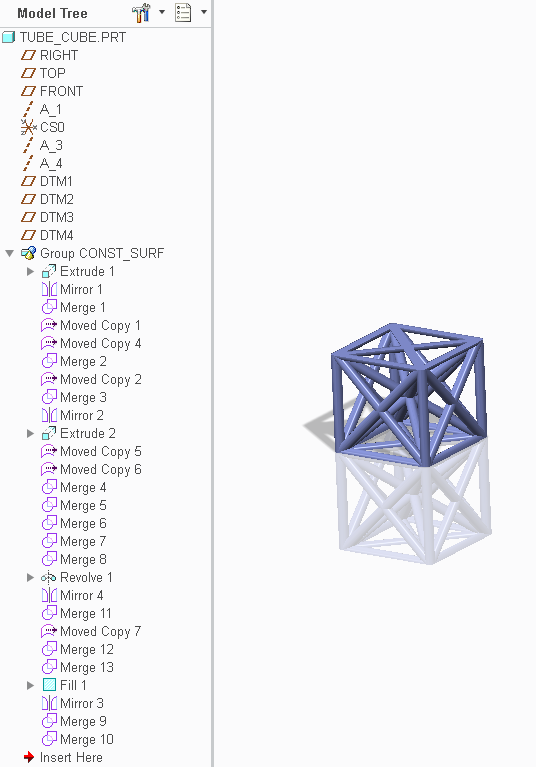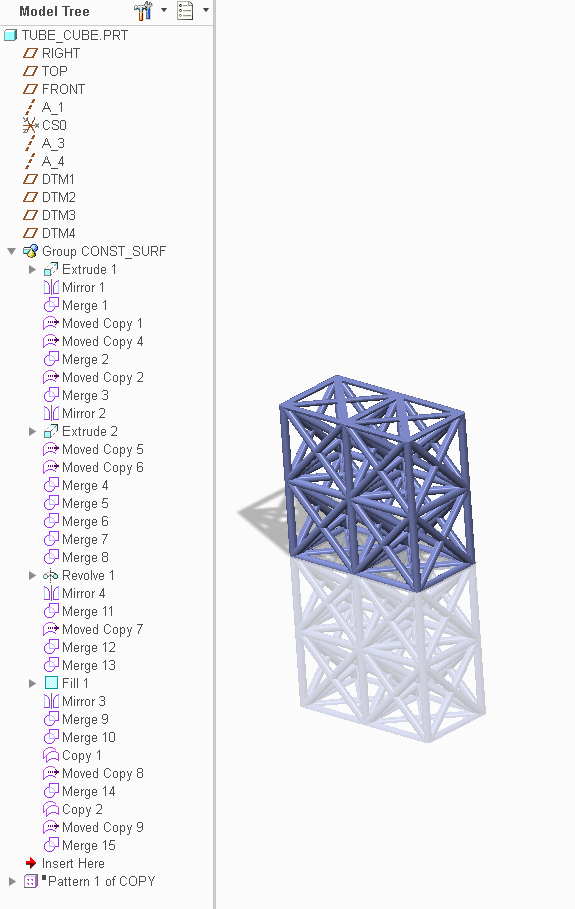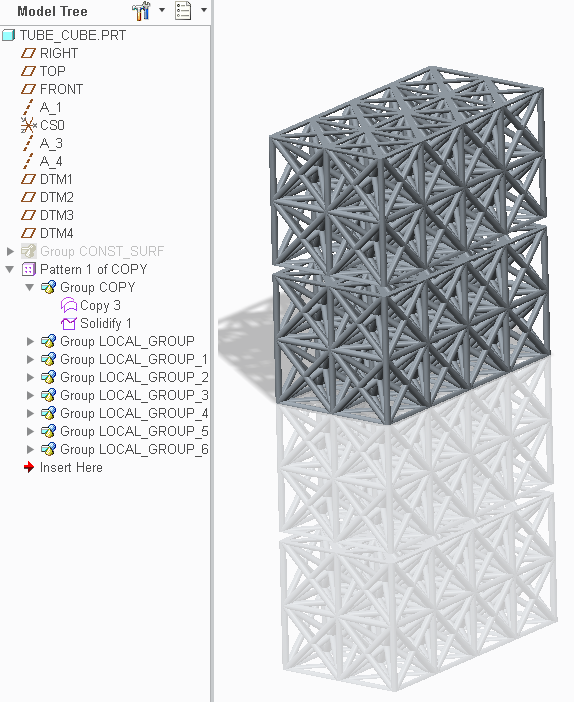Community Tip - Have a PTC product question you need answered fast? Chances are someone has asked it before. Learn about the community search. X
- Community
- Creo+ and Creo Parametric
- 3D Part & Assembly Design
- Question regarding modelling
- Subscribe to RSS Feed
- Mark Topic as New
- Mark Topic as Read
- Float this Topic for Current User
- Bookmark
- Subscribe
- Mute
- Printer Friendly Page
Question regarding modelling
- Mark as New
- Bookmark
- Subscribe
- Mute
- Subscribe to RSS Feed
- Permalink
- Notify Moderator
Question regarding modelling
Hi guys,
So i have tried patterning and mirroring my design and creo 3.0 parametric always failed to regenerate the structure that I'm trying to make. Attached is the structure and design that I'm trying to make and I have tried mirroring the big structure but it always come up to regeneration error. Is there anyway I could fix this problem?
Thanks!
This thread is inactive and closed by the PTC Community Management Team. If you would like to provide a reply and re-open this thread, please notify the moderator and reference the thread. You may also use "Start a topic" button to ask a new question. Please be sure to include what version of the PTC product you are using so another community member knowledgeable about your version may be able to assist.
- Labels:
-
Surfacing
- Mark as New
- Bookmark
- Subscribe
- Mute
- Subscribe to RSS Feed
- Permalink
- Notify Moderator
Hi,
you have to upload your part, if you want to get useful advice. Your picture do not show the root of the problem.
Use How to Attach a File to a Discussion Reply procedure.
MH
Martin Hanák
- Mark as New
- Bookmark
- Subscribe
- Mute
- Subscribe to RSS Feed
- Permalink
- Notify Moderator
Hi Kong, yes, there is always a way to fix the problem.
to help us help you, take a snapshot of YOUR model tree with the local_group and pattern expanded.
sounds like you want to create a pattern like the 1st snapshot using the geometry you
created in the 2nd snapshot?
assuming yes
the first snapshot looks like it was constructed using good modeling practices, study it
.....the answers to you seek are there.
my guess is that in the local_group there are gaggles of features most likely surfaces all
merged together to create a quilt (2) cubes wide x (2) cubes tall .
the final quilt is copied, solidified grouped and the group is patterned.
patterns are tricky, to say the least...good modeling practices are a must.
every reference you use in every feature that is in the pattern has to be able
to be reproduced in every instance. so in many cases your forced to add extra
overhead, which leads to gaggles of extra features which lead to long regeneration's/fails.
try converting the structure your looking for from solids to surfaces and merge into a closed quilt.
from there you can mirror/move_copy the quilt (not the features) to create the 2x2, merge the (4) quilts.
if the 2x2 quilt is closed you will be able to solidify it into a solid.
there are (2) big advantage doing it this way.
the first is, the pattern feature will be happy as long as the quilt you used for the solidify is happy and closed,
no matter what it looks like. in this case you could go back in time and add or remove tubes or remove everything
and add a revolved surface, what ever floats your boat. just redefine the solidify and pick a new quilt.
the second is, when using surface copy_solidify_group_pattern you are only regenerating (2) features per instance.
the snapshots below are the (3) main stages. the 1st is a closed quilt of the main structure, the 2nd is a closed quilt
of the 2x2 structure, the 3rd is the 2x2 quilt solidified, grouped and patterned.



there is a creo2 model attached. for the sake of time I cut some corners and because hindsight is 20/20
I would approach the the construction a little different...but...this is what I got in 1-1/2 hours. to decrease the
file size the pattern is suppressed and the surface layer is hidden.
good luck
- Mark as New
- Bookmark
- Subscribe
- Mute
- Subscribe to RSS Feed
- Permalink
- Notify Moderator
I have seen this model before. If I could recall I could point to the previous solution.
Other than that, regen failure is typically a numeric calculation failure which is controlled by accuracy. I would choose absolute accuracy so that the calculations were independent of part size.
The default relative accuracy changes the likelihood of regen failure as the part size changes.
- Mark as New
- Bookmark
- Subscribe
- Mute
- Subscribe to RSS Feed
- Permalink
- Notify Moderator
Agreed. Increase your part's modeling accuracy.
- Mark as New
- Bookmark
- Subscribe
- Mute
- Subscribe to RSS Feed
- Permalink
- Notify Moderator
It varies. In some models making the accuracy value smaller helps; in others it helps to make it larger. In models where there is a significant change to the model size, absolute provides some measure of stability.
I've inherited some models where making any change causes the model to fail; I observe this is a result of regenerating features that must have had internal states saved and a real regen causes those states to be recreated. Of those models increasing the number and decreasing the number and even setting the number to the original value caused different sets of features to fail. Very frustrating when a new feature is required and it fails.
Most of these have been related to rounds which, in quantity, can be overlooked when they disappear, but there are plenty of others.
It would be ideal for PTC to do two things - 1) Actually regen every feature every time unless specifically told not to. This would eliminate the transference of these landmines to later users. 2) Allow accuracy to be embedded at each feature. The entire model is only regenerated one step at a time and each step has independent calculations.
- Mark as New
- Bookmark
- Subscribe
- Mute
- Subscribe to RSS Feed
- Permalink
- Notify Moderator
Yes, the "Borg cube" was discussed extensively in this thread:





